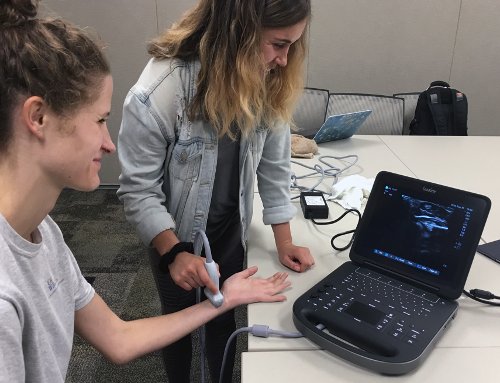
Medical students from Oakland University William Beaumont School of Medicine recently found themselves in the unique position of teaching residents when their point-of-care ultrasound peer-to-peer training program changed course as a result of the COVID-19 pandemic.
The students, along with Arati Kelekar, M.D., an internist at Beaumont Health and OUWB faculty member, got creative and developed a way to offer the training virtually to Beaumont residents -- not the typical flow of training or information sharing. Specifically, they taught the residents how to use technology that is increasingly being utilized in health care.
“The pandemic offered this unique opportunity, which I think these students made good use of,” said Kelekar. “They decided to capture an audience that was still not very familiar with this particular kind of training.”
By design, the program calls for a small group of OUWB students to begin training at the end of their first year in point-of-care ultrasound techniques. Students would then disseminate that information to their peers.
Point-of-care ultrasounds are not meant to replace traditional ultrasounds.
They can be useful in many ways, however, especially in acute situations where patients might present with heart issues, shortness of breath, or musculoskeletal abnormalities. That makes point-of-care ultrasound especially valuable in urgent care centers, emergency rooms and in making critical decisions in hospitalized patients.
Kelekar said point-of-care ultrasound training continues to gain traction as part of today’s medical school curriculum, especially as equipment becomes increasingly portable and less expensive.
‘A very good experience’
The new volunteer, peer-to-peer program is an offshoot of OUWB’s Art and Practice of Medicine, a longitudinal course that introduces and develops students’ history-taking and physical-diagnosis skills.
Students interested in being peer tutors apply and are interviewed at the end of their first year of medical school. (Plans for the next group of peer tutors are temporarily on hold due to the COVID-19 pandemic.)
For the inaugural group, five students were selected. Now all third-year medical students, they are Rachel Harvey, Benjamin Malamet, Rachel Kalthoff, Lucas Nelson, and James Blumline.
Over the course of several months, radiologists and other physicians with expertise in bedside ultrasound use train the students in the basics of point-of-care ultrasound, system-by-system (lungs, cardiac, abdominal, etc.).
The students practice with each other until they have enough expertise to share with their OUWB peers.
Though several sessions had to be canceled, Kelekar said she knew residents could benefit from the basic training that the medical students could offer.
“Basically, what’s happened is that point-of-care ultrasound is gaining more and more popularity in medical school curriculums, which means current students are ahead of the game compared to many residents, particularly those in internal medicine,” said Kelekar.
Harvey said the students prepared a didactic that included a PowerPoint presentation, demonstration of the various types of probes and their applications, and videos of sonographic examination techniques they filmed at the Clinical Skills Center.
About 20 residents took part in the session.
Kelekar praised the students for their presentation. Harvey said she’s “learned a lot” throughout the entire process of being a peer tutor.
“Currently, I’m working in the pediatric cardiology office at Beaumont, Royal Oak and we’re looking at a ton of (echocardiograms) and I would have no clue what they actually were showing had I not done this program,” she said.
Harvey said she also gained insight into the teaching aspect of medical education.
“It was a very good experience in medical education and teaching and working with others,” she said. “I have a lot of experience in being a student, but not as much in being a teacher. It was really great to take the opposite perspective.”
For more information, contact Andrew Dietderich, marketing writer, OUWB, at [email protected].
Follow OUWB on Facebook, Twitter, and Instagram.
NOTICE: Except where otherwise noted, all articles are published under a Creative Commons Attribution 3.0 license. You are free to copy, distribute, adapt, transmit, or make commercial use of this work as long as you attribute Oakland University William Beaumont School of Medicine as the original creator and include a link to this article.

